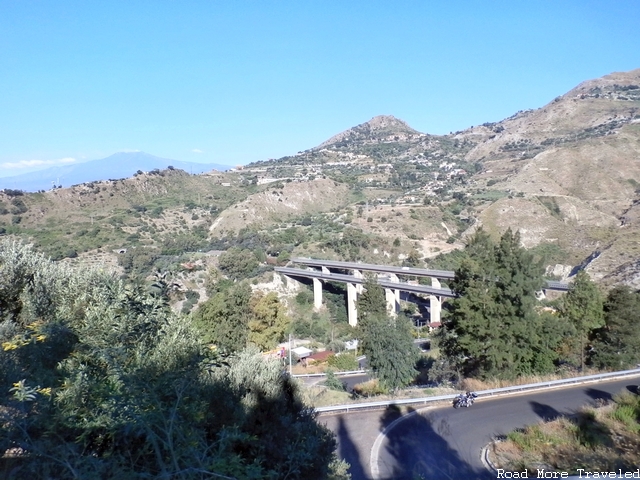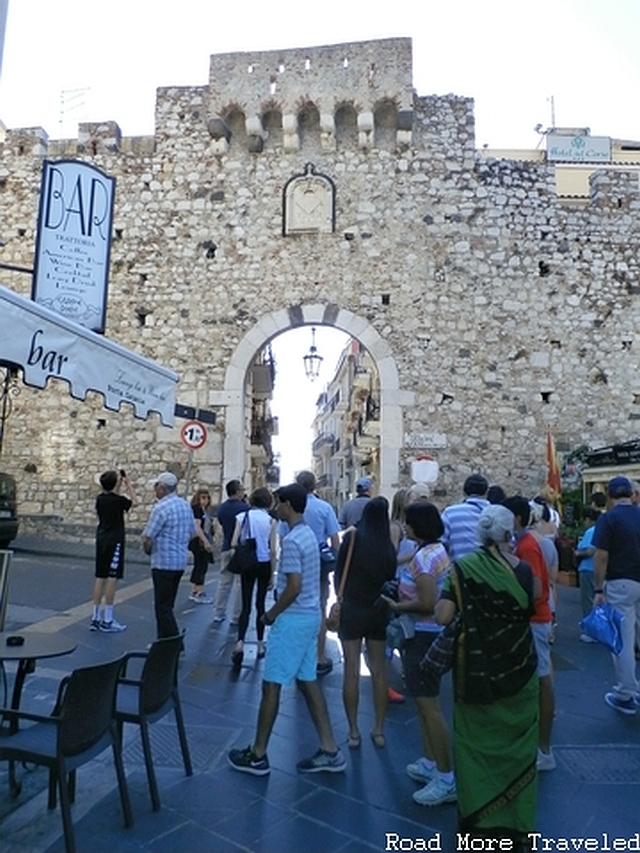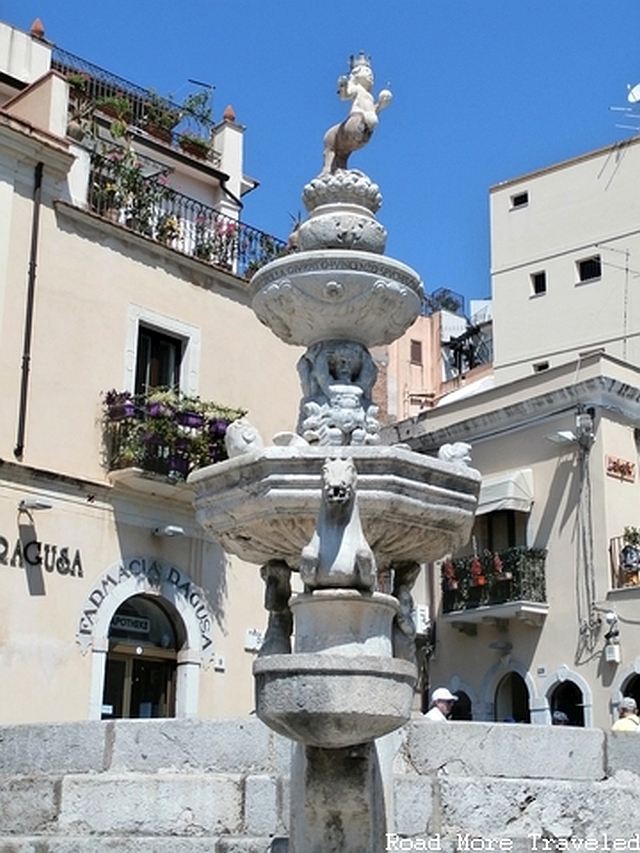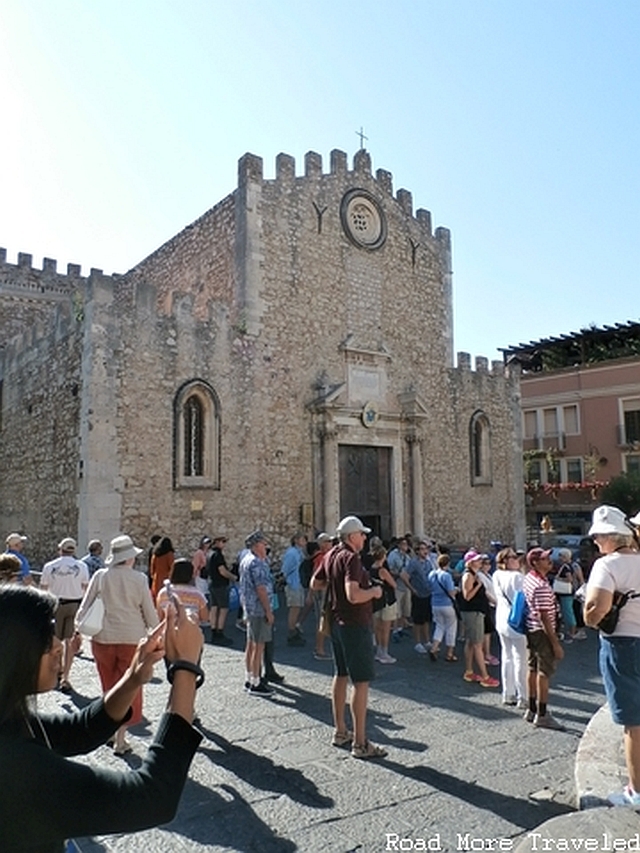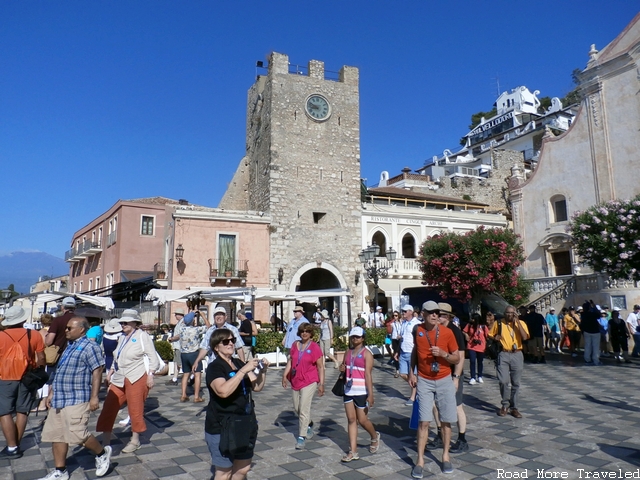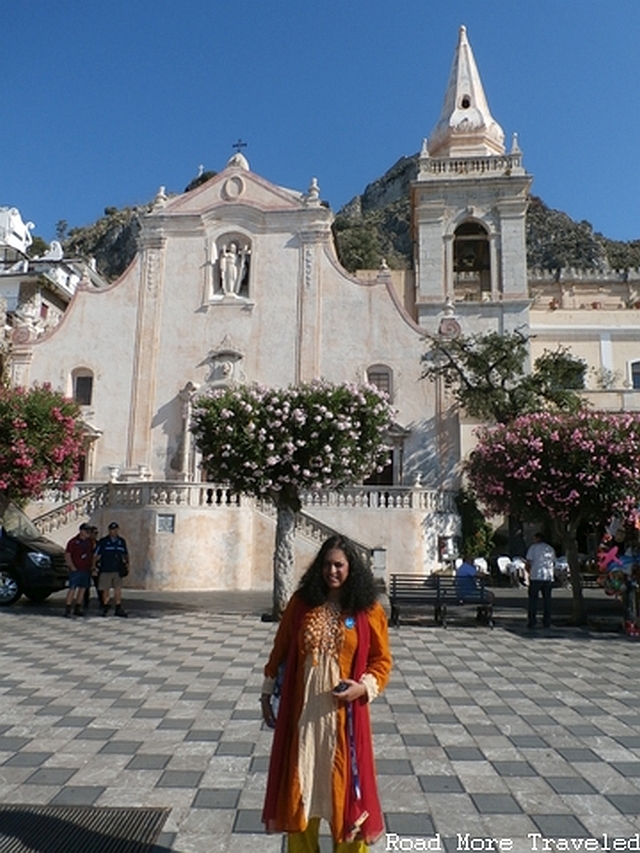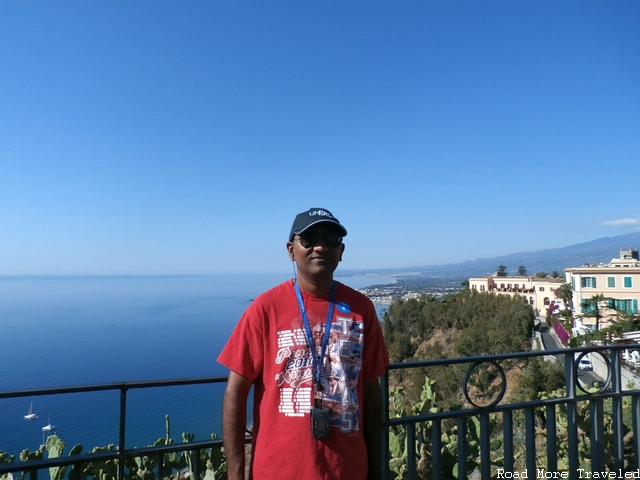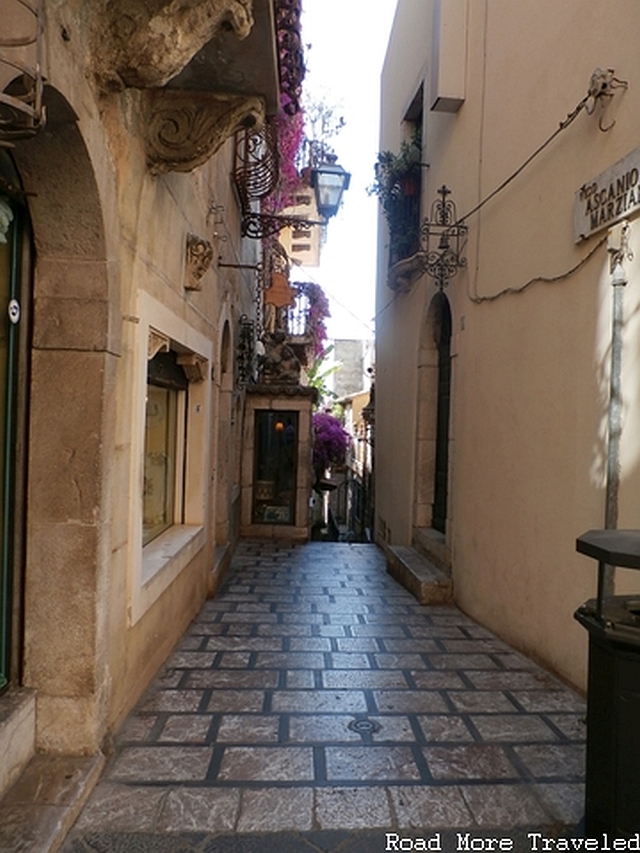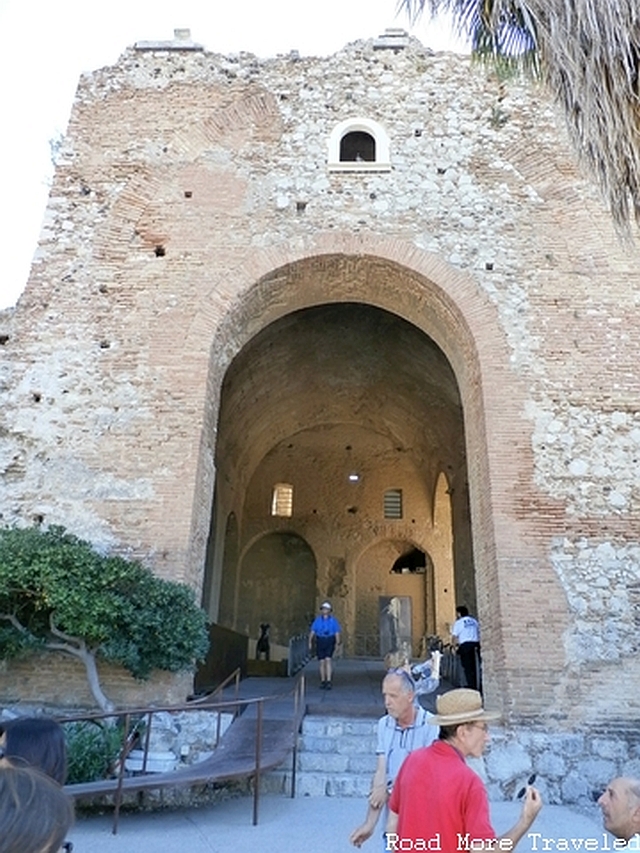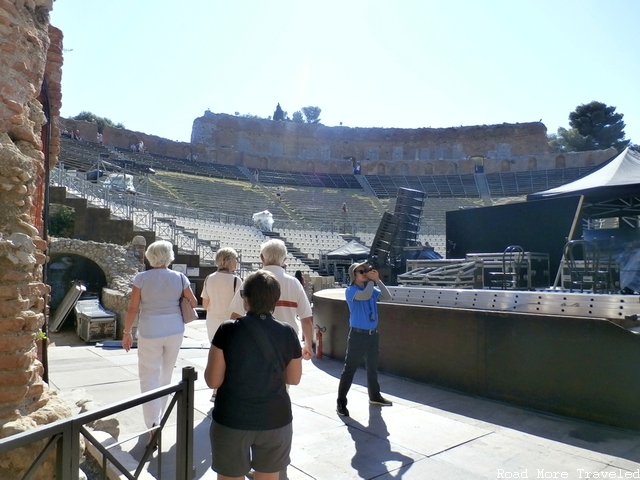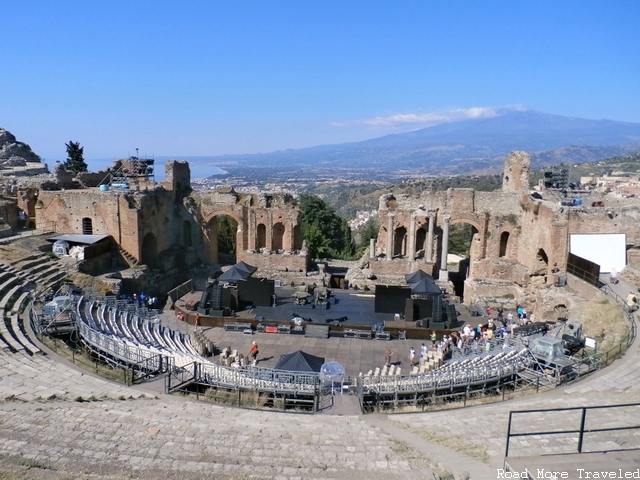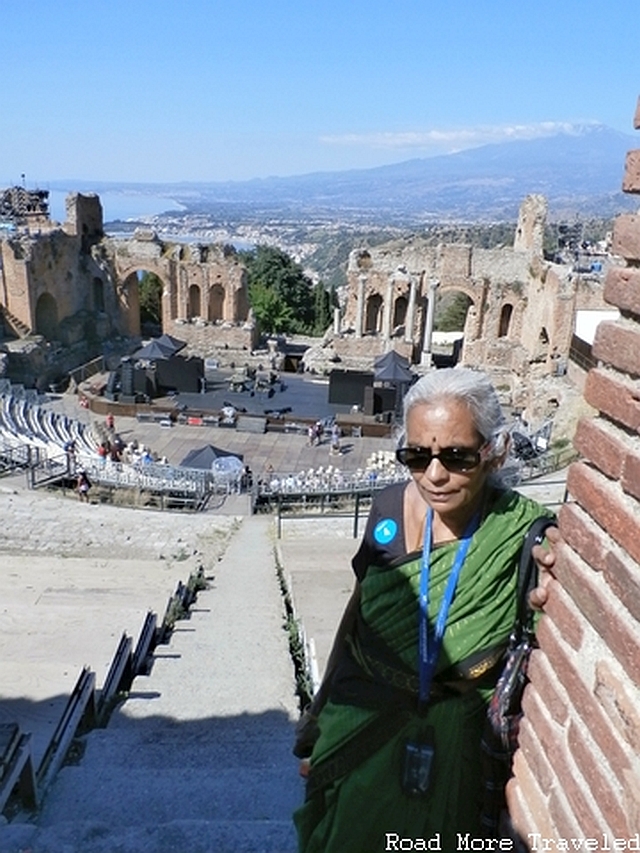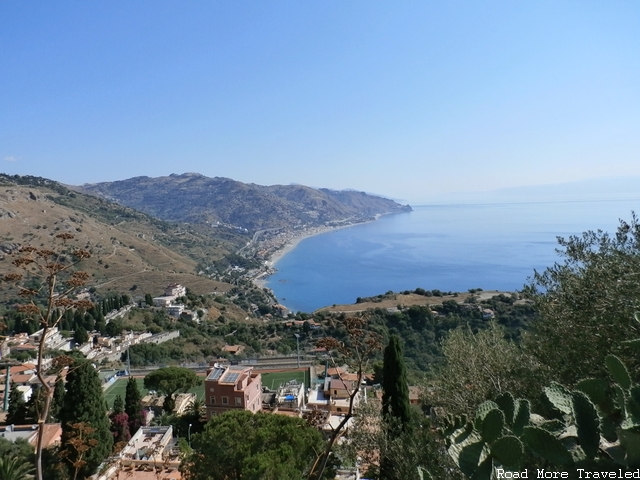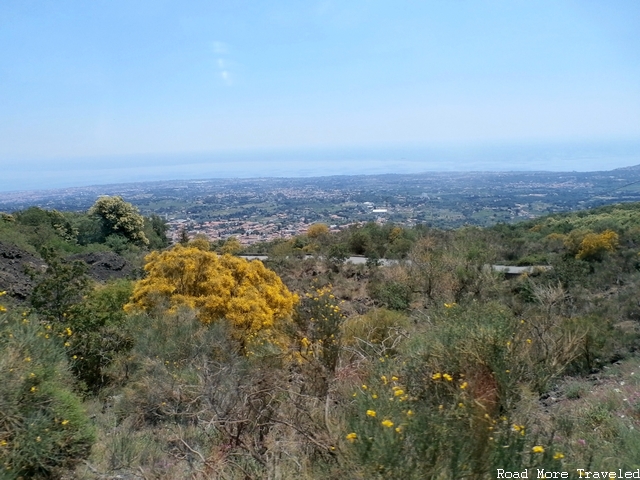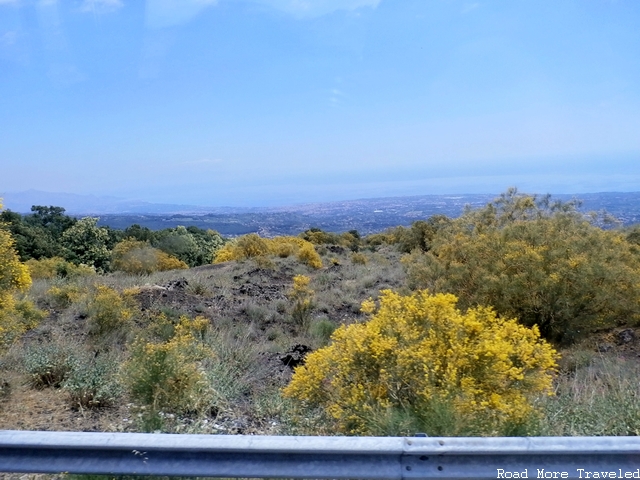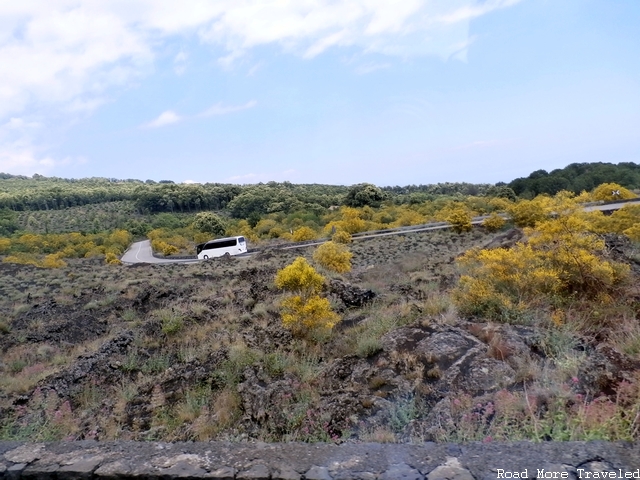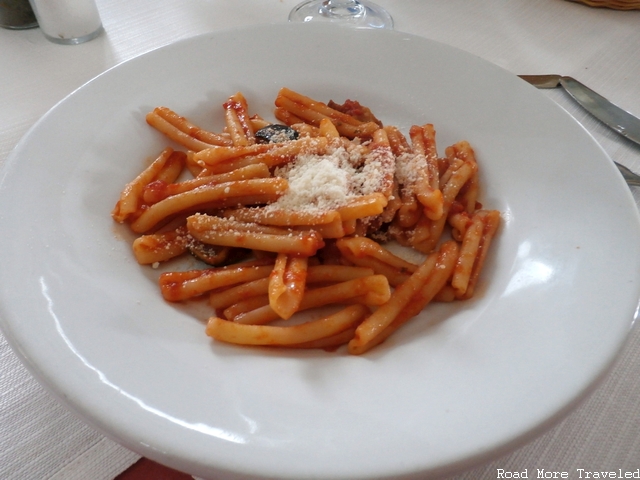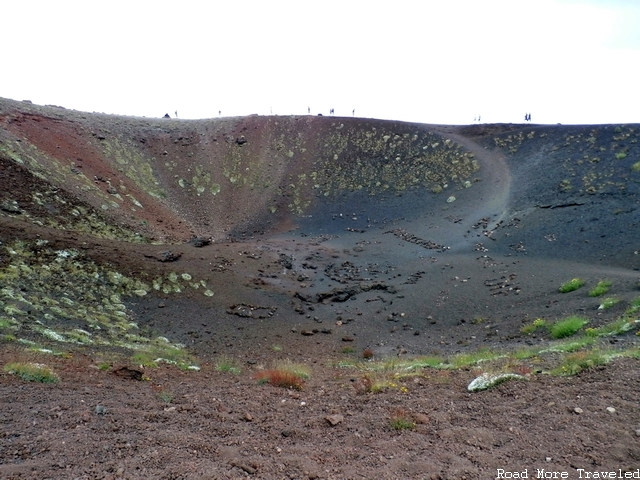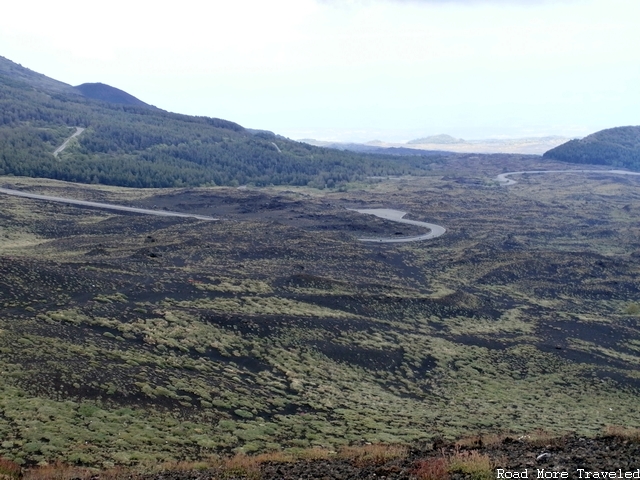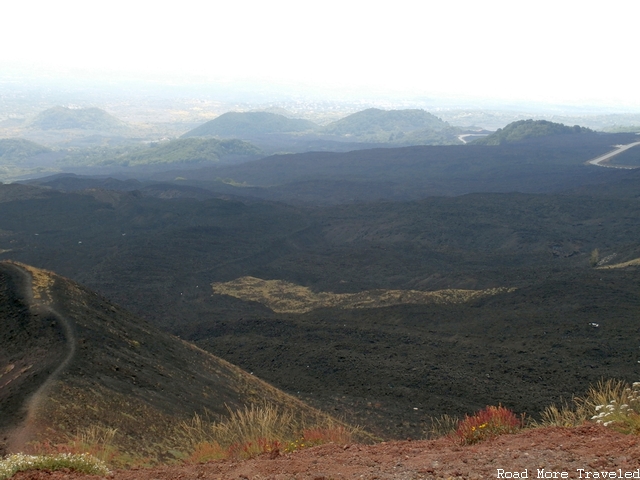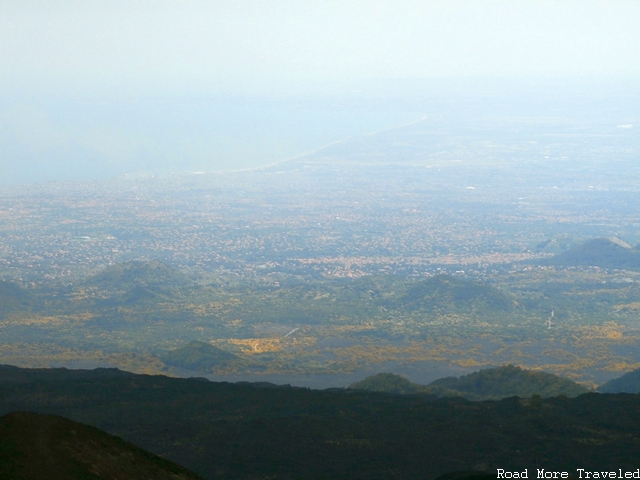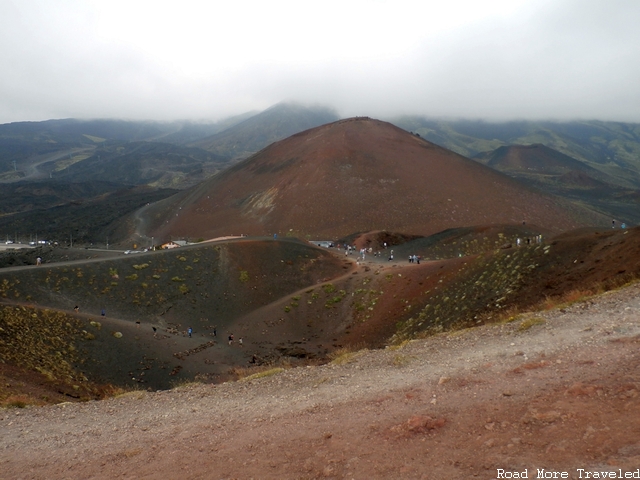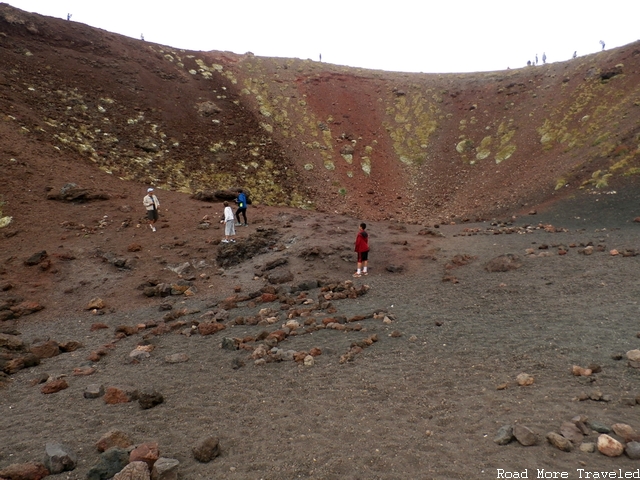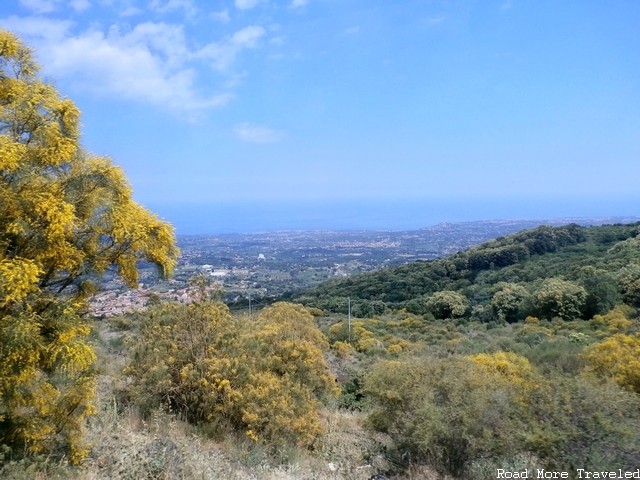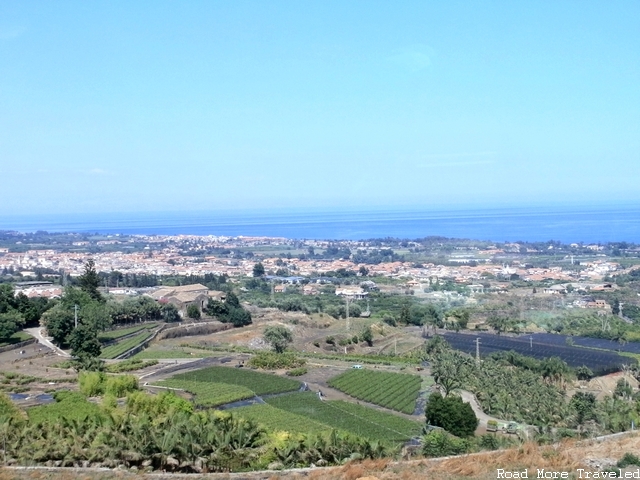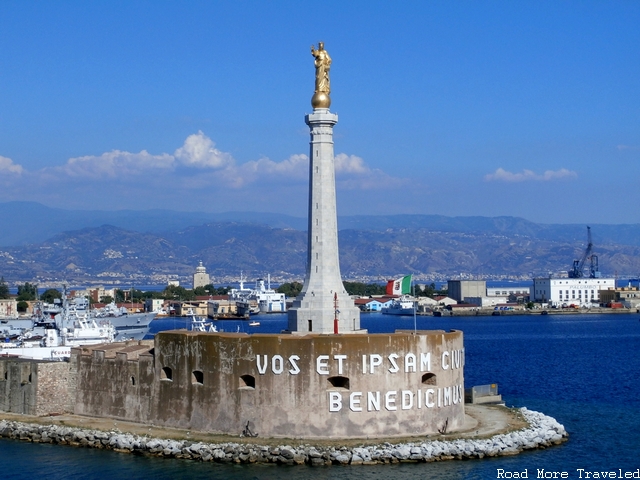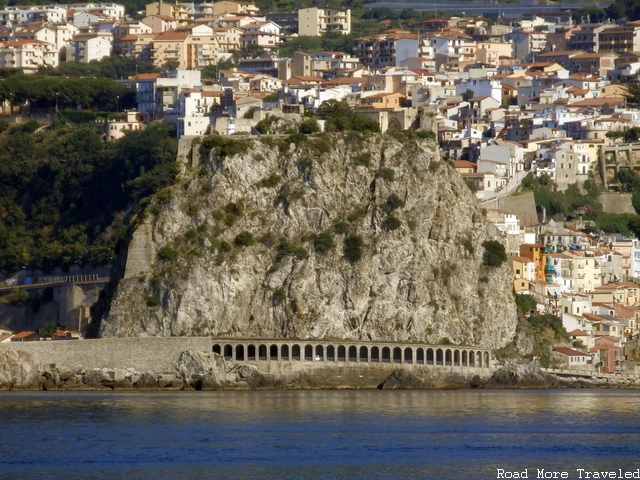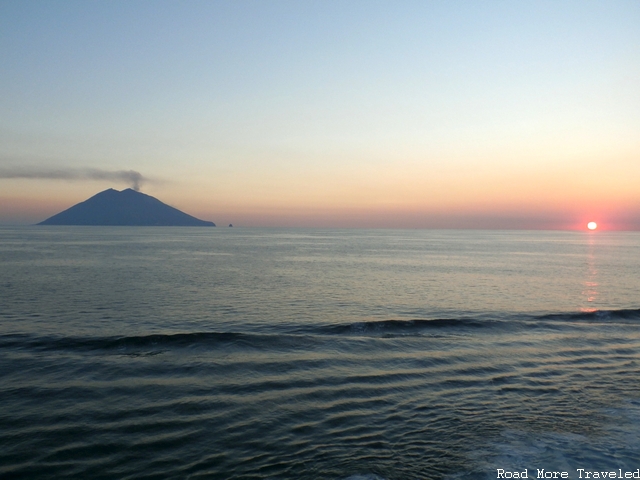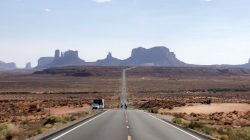After a short (by ship standards) ride from the tiny but adventure-filled island of Malta, the Emerald Princess docked in the city of Messina, on the island of Sicily, early the next morning. My wife and I went to Italy back in 2006 for our honeymoon, but our tour that year didn’t go south of Sorrento, so this would be something new. Today would also be the designated day where all 11 of us – that’s my wife and I, mom, brother, two sisters, two brothers-in-law, and three nephews for those of you counting at home – would all go on the same tour.
It was the tour I perhaps looked forward to the most on the cruise. That’s because I’m a sucker for road trips, and this tour included a pretty good sized one. The tour first visited the historic village of Taormina, followed scenic drive to Mount Etna. (The road ends at the 6,500 foot level, so you don’t get to visit the summit). That’s a lot to see, and our tour was scheduled to take up literally every minute we’d be in port. Time to hit the road early.
Date of visit: Thursday, July 2, 2015
If you’re visiting Sicily, be aware, while it looks small on a map, it’s deceptively large. Messina, where most of the large cruise ships dock, is on the far northeastern end of Sicily. Though only about 50 km (30 miles) to Taormina and 100 km (60 miles) to Crateri Silvestri on Mount Etna, it’s roughly 160 km/100 mi to Siracusa, 225 km/140 mi to Palermo, and 350 km/215 mi to Marsala on the far west end of the island. If you only have one day in Sicily, you’re just not going to have time to make it much farther than Mount Etna and actually have time to see things.
Traffic in Sicily isn’t quite as chaotic as mainland Italy, but use caution if driving yourself. “Restricted entry zones” and parking restrictions plague Messina, Catania, and Palermo. These are often poorly marked, yet result in significant fines for even inadvertent violations. It’s better to park on the edge of the city center and walking or riding the bus the rest of the way in, anyway. “Old city” areas often feature narrow streets that can be difficult to navigate. And before anyone asks, no, we did not try to seek out the Mafioso while in Sicily. Not surprisingly, though, there are tours for that sort of thing. You have to head all the way out to Palermo and Corleone; unfortunately, you won’t have time if your ship docks in Messina.
The first part of the journey was easy – 30 miles on the autostrada to the edge of Taormina. The village itself sits on a hillside overlooking the Ionian Sea, at an elevation of roughly 800 feet. But the ride from the autostrada built through the valley below requires a short but winding drive up the hill.
Taormina dates back back thousands of years, though the first permanent settlement appeared around the 8th century B.C. Then, settlers from the Greek colony Naxos established a town on the site called Taruomenium. Taormina remained under Greek rule until sometime around the 2nd century B.C., when control of Sicily passed to the Romans. Unlike most of the rest of Sicily, however, Taormina retained an important position even under Roman rule. In fact, it continued to flourish even after the fall of the Roman Empire. That’s despite changing hands among various powers multiple times.
The village became a popular tourist resort by the 19th century, attracting famous visitors such as Oscar Wilde. During the late 19th and early 20th centuries, Taormina became something of a hipster’s colony, attracting artists and writers from around the world. You don’t really feel that vibe here today, though the town is still home to an annual performing arts festival in the summer, “Taormina Arte”.
Much like Mdina in Malta, Taormina is a walled city, with visitors having to pass through a gate to enter. Also like Mdina, most vehicles are prohibited from entering the walled city, except for residents and local deliveries. Visitor traffic must stop at the edge of town; a large parking garage is located near the main gate. However, to reach the the village itself, you must walk up a steep staircase. The main gate is called the “Porta Catania”. You can see the Roman influence with the arched doorway and keystone, the general look almost seems medieval English in a way.
Just inside the gate is the Piazza Duomo. It’s a small square featuring the town’s official fountain (fontana), and the Duomo di Taormina.
The Baroque fountain dates to the 17th century. Its crown features a mythical figure that is half woman/half bull, also found on Taormina’s coat of arms. While perhaps not quite as breathtaking as its more famous cousin in Milano, the Duomo di Taormina, dedicated to St. Nicholas, dates to the 13th century and features a classic medieval look.
The actual walled section of Taormina doesn’t last long, and after just 300 meters, you pass through the unnamed gate on the other side. Here, though, are some sights you definitely don’t want to miss. As you pass through the gate, you enter the sweeping Piazza IX Aprile di Taormina, with its charming checkerboard-tiled pavement.
On one side of the piazza is the gorgeous Chiesa di San Giuseppe (Church of St. Joseph), a Baroque/rococo church built in the second half of the 17th century.
The most unique feature of this church is probably the double staircase that leads from the piazza to the front door, along with the various shades of white, grey, and pink marble used throughout. I guess most of all, a picturesque church in a piazza, on a perfect sunny day, surrounded by flowering trees, just screams “Italy” more than anything else. Meanwhile, on the other side of the piazza is an absolutely fantastic view of the sea below.
The main street of the town continues straight ahead for about 350 meters, lined with a mix of high-end clothiers, jewelry/blown glass shops, and restaurants and bars that seemed to be doing a brisk business selling espresso at this early hour. Quieter side alleys also show off the rustic charm that Italian villages are so famous for.
The main street turns abruptly to the right after you pass Santa Caterina Church. After initially passing through an area full of street vendors selling fruits & vegetables and cheap trinkets, about 2/3 of a kilometer later, you arrive at the crown jewel of the town, the Teatro Antico di Taormina, sometimes called the Teatro Greco. The exact origins of the theater are unknown, and exactly who built it, the Greeks or the Romans, remains in dispute. Archaeologists believe that based on its structural design, it was built by Roman engineers for use by the city’s Greek residents in the first or second century B.C.
On the other hand, other design cues, particularly the use of well-cut stone below the stage, suggest that the theater was built by the Greeks around the middle of the 3rd century B.C., and later enlarged by the Romans. In any event, the Teatro Antico is the second largest theater in Sicily, behind only the one in Siracusa, with an estimated maximum capacity of 5,400 persons. The theater is still in use today, particularly for the “Taormina Arte” festival.
Main entrance to the theater
View of the theater bowl from the main entrance
If you don’t mind a little bit of a workout, a special treat awaits those who climb to the top of the theater – a spectacular view of the theater, the Ionian Sea, and Mount Etna all in one. As an added bonus, you can see the volcano smoking just a little bit.
Special props to my mom for making it all the way to the top.
Behind the theater is another great view, this one of the Bay of Naxos and the coast heading off to the north.
After a stop for espresso, pastries, and pizza (yes, pizza at 10 A.M. – hey, it’s Italy), we boarded the bus to head for the big volcano seen in the photo from the theater, Mount Etna. We wouldn’t be heading all the way to the top of Mount Etna; rather, we’d be stopping for lunch at Crateri Silvestri, a currently dormant crater at an elevation of approximately 6,500 feet, with some free time after lunch for exploring. The distance itself isn’t that far – about 55 kilometers (34 miles), but due to the steep, winding road over the last 20 kilometers or so, the drive would take about an hour and 15 minutes. The climb really starts once you pass the town of Zafferana. Those seated on the right-hand side can sneak occasional peaks of the ocean below, along with the thickening vegetation at this elevation.
As you head higher up, though, the vegetation thins out, and the landscape becomes pockmarked with black volcanic rocks as you enter more recent lava flow zones. And you can also see just how twisty this road is, as it winds its way up the side of Mount Etna.
We eventually made it to Crateri Silvestri, and the restaurant and bar where our lunch was scheduled. The service was excruciatingly slow, and the main course of veal cutlet was forgettable. But we did receive an excellent bruschetta, and a primi piatti of pasta alla Norma. It’s a simple dish featuring pasta in tomato sauce with sauteed eggplant. This was really delicious.
The meal took so long, I was afraid our tour guide might cut out our crater time completely. Thankfully, he still gave us 30 minutes. That’s one advantage to a ship-sponsored excursion; the ship must wait until all tour guests return.
Crateri Silvestri is actually a series of several craters and cones created by an eruption in 1892. Not only can you climb to the tops of the cones for scenic views of the Sicilian countryside, you can scamper down into the craters to explore the almost Martian-like landscape. As you walk back to the craters from the restaurant, you’ll see two sets of hiking trails. The left trail leads up to a higher ridge and (probably) better views, but we didn’t have enough time. So I chose the right trail instead. It’s a short hike to the top, and you can then look down into the depths of the crater.
You can see what I mean when I say almost Martian landscape. It’s a sea of red pumice with just a few sprigs of grass and flowers coming through. To the east, you can see the crazy, serpentine road we drove up to get here.
To the south is a sea of black volcanic rock, indicative of a significant lava flow. If you’ve ever driven Highway 60 in the vicinity of Show Low, Arizona, you’ll see a similar lava flow landscape in that area.
To the southwest is probably the best view of all. The overcast obscures things, but you can see both the lava flow and bright yellow flowers on the west slope. You can also see the Ionian Sea in the distance.
Here to the north, you can also see the cone and path to the left of the road I was talking about. I would have loved to crawl up there but…so little time. You can also see more of the Martian landscape here.
Having completed a walkaround, I spent a few minutes hiking down into the crater directly in front. You don’t need hiking shoes to do it, but the loose pumice makes for poor footing. It’s also a pretty steep drop, so use caution (or just slide down on your rear end). You’ll also have to run pretty good to get back up. So how’s the view from down below? It’s kind of like an ant standing in a bathtub.
I wanted more time to explore, but alas, we had to head back to Messina and the ship. On the way down, we caught more views of the villages and sea down below.
And finally, nearly all the way down, a great view of the farmland and the outskirts of Catania.
We made it to the ship just as they announced final call. So, we headed straight to our cabin to watch the ship leave from our balcony. Just off our balcony was a large monument, which I later found out is the Madonna of the Letter.
According to legend, St. Paul arrived in Messina to preach the gospel. Many of the local peoples accepted his invitation to convert to Christianity. In 42 A.D., when Paul returned to the Holy Land, several of the converts asked him if they could accompany him to meet the Virgin Mary. A delegation did indeed accompany him and delivered a letter to Mary, professing their faith and asking for her blessing. Mary in turn sent back a letter, praising their faith and closing with “Vos et Ipsam civitatem benedicimus“, or “We bless you and your city”. The monument, bearing the same inscription, was dedicated in 1934.
A few minutes after leaving port was an interesting sight on the Italian mainland, just a few miles away. It looked like a Roman aqueduct cut into the side of a hill near the town of San Giovanni.
And last but not least, one of the highlights of our cruise so far. As the sun prepared to set, we passed close to the island of Stromboli. You may recognize it for its active volcano of the same name. Our ship passed at a perfect angle, allowing me to capture both the smoking volcano and the sun dipping below the horizon in the same frame.
If you were looking for a better reason to go cruising – there you have it right there.
Next stop: the Emerald Princess reaches the mainland of Italy with a stop in Napoli.
Note: this post is part of my multi-part trip report series about my wife and I’s trip to Europe in June/July, 2015. Read the trip report introduction for an index and background about our trip.


